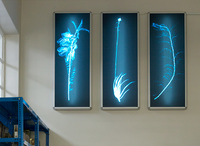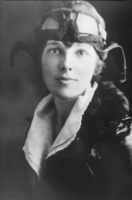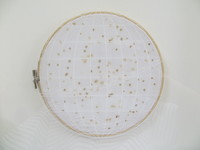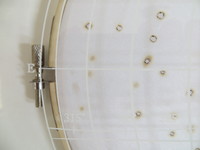Items
Site
The Medicine Chest
keywords is exactly
mystery
-

Planthology (detail)
“For 'Planthology (Bulbine frutescens and Lessertia frutescens)' I sourced two medicinal plant specimens from Kirstenbosch National Botanical Garden and x-rayed them at Groote Schuur Hospital (#10 and #13). These two local plants offer a wide variety of healing properties and address the lacuna of the chest. The fresh leaves of the Bulbine frutescens produce a jelly-like juice that can be used for burns, rashes, blisters, insect bites, cracked lips, acne, cold sores, mouth ulcers and areas of cracked skin, while an infusion of these leaves in a cup of boiling water can be taken for coughs, colds and arthritis (Harris 2003: online). The Lessertia frutescens is used as an immune booster in the treatment of HIV/AIDS, as a medicine in the treatment of chicken pox, internal cancers, colds, asthma, TB, bronchitis, rheumatism, rheumatoid arthritis and osteoarthritis, liver problems, haemorrhoids, piles, bladder and uterus problems, diarrhoea, dysentery, stomach ailments, heartburn, peptic ulcers, backache, diabetes, varicose veins and inflammation (Xaba & Notten 2003: online)” (Liebenberg 2021: 269). -

Planthology
In conversation with Dr Yeats in 2011 about adding a few medicinal plants to the centre as part of its displays, she mentioned that no plants survived in there. They all seemed to die from some mysterious cause. I decided to source three medicinal plants, the Lessertia frutescens, Bulbine frutescens and Artemisia afra, and X-ray them to 'diagnose' what might be the cause of their demise. In subjecting the plants to this process and placing the x-ray images in a space that foregrounds the diagnosis of human disease, I intended to create a heterarchical shift in this relationship, considering a world in which the degree of care directed toward human ailments might be replicated in treating diseases manifest in the botanical world. -

Aurora Borealis
Extract from 'What to Observe', 1841, written by Julian Jackson (The Royal Geographical Society) -

Earhart's pilot license #6017 photo
-

Amelia
"We are on the line 157 337. We will repeat this message. We will repeat this on 6210 kilocycles. Wait." On July 2, 1937 Model 10 Electra 1055 piloted by Amelia Earhart with navigator Fred Noonan took off from Lae Airfield, New Guinea and was never seen again. Earhart's last radio message was estimated to be within 200 miles of her destination Howland Island. Burn holes made with a magnifying glass on a handkerchief which corresponds to the positioning of the stars as observed from the place, date and time Amelia Earhart sent her last broadcast. -

Amelia (detail)
"We are on the line 157 337. We will repeat this message. We will repeat this on 6210 kilocycles. Wait." On July 2, 1937 Model 10 Electra 1055 piloted by Amelia Earhart with navigator Fred Noonan took off from Lae Airfield, New Guinea and was never seen again. Earhart's last radio message was estimated to be within 200 miles of her destination Howland Island. Burn holes made with a magnifying glass on a handkerchief which corresponds to the positioning of the stars as observed from the place, date and time Amelia Earhart sent her last broadcast.


